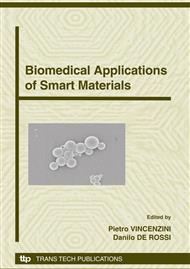p.1
p.5
p.15
p.22
p.31
p.37
p.44
p.50
Encouraging Nature with Ceramics: The Roles of Surface Roughness and Physio-Chemistry on Cell Response to Substituted Apatites
Abstract:
The success or failure of a bioactive ceramic implant material in the body depends on a complex interaction between a synthetic foreign body and the host. These interactions occur at many levels from the nano-structural level, where subtle changes in surface physio-chemistry substantially alters the nature of the biomaterial-host tissue interface, to the meso- or macrostructural level where dependence on porosity mediates bioactivity through its effect on nutrient transfer and scaffold mechanics. Thus the factors that control the biological response to implant materials are a complex combination of mechanical, physical and chemical attributes which when combined favorably lead to ‘bioactivity’ in a material, or more correctly a ‘bioactive’ response to the material. This is illustrated in the successful use of porous bioactive ceramic scaffolds as synthetic bone graft substitute materials, where micro and meso-porosity, bulk and surface chemistry are manipulated to provide a framework that is highly conducive to the process of bone regeneration, balancing bone apposition and remodeling. Moreover, we now have the opportunity to developing an understanding of the complex balance of forces at play during bone grafting through investigation of these biological responses.
Info:
Periodical:
Pages:
22-30
Citation:
Online since:
September 2008
Authors:
Price:
Сopyright:
© 2008 Trans Tech Publications Ltd. All Rights Reserved
Share:
Citation:


